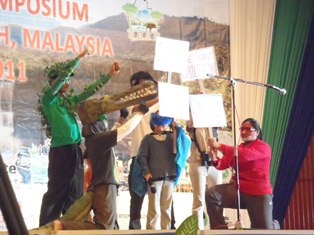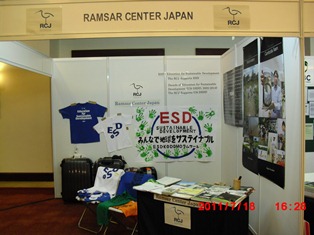| ●「アジア湿地シンポジウム・サバ2011」報告● 24国322人参加。「Sabah Call for Action(サバ・コール)」を採択 |
| 7月18〜20日、マレーシアのコタキナバル(サバ州)で、「アジア湿地シンポジウム・サバ2011(AWSサバ2011)」が、サバ州政府の主催、ラムサールセンター、JICA、サバ大学などの共催で開催されました。24か国から322人(日本人63人)が参加し、湿地と森林の統合的な保全・管理と賢明な利用の実現をうながす「サバ・コール」を採択し、幕を閉じました。 今年はラムサール条約40周年、ユネスコMAB(人間と生物圏計画)40周年、国際森林年、そして国連生物多様性の10年の初年度と、地球自然環境保全に関わる国際的協力の強化・深化をうながす複数の枠組のキャンペーン年にあたり、初日の基調講演には、ラムサール条約、生物多様性条約、ユネスコMAB、国連森林フォーラム各事務局のハイレベルのスピーカーが顔をそろえました。日本からは、AWSの継続的なスポンサーである経団連自然基金(KNCF)を扱う経団連自然保護協議会会長の大久保尚武さんが、生物多様性保全への産業界の責任と取り組みについて特別プレゼンテーションをおこないました。 「ラムサール条約と生物多様性条約」、「地域協力の推進」、「森林と湿地」、「ビジネスと湿地の生物多様性」、「湿地と生物多様性のためのCEPA」、「森林と湿地の文化遺産としての価値」、「サバの湿地」の7テーマでおこなわれた分科会では、合計56編の研究発表があり、活発な質疑が展開されました。ポスター発表も8編おこなわれました。 RCJの活動の発表としては、CEPAの分科会で市川智子さんが「KODOMOバイオダイバシティ」について口頭発表をおこなったほか、RCJのKODOMOプログラムに継続的に参加し、KODOMOリーダーとして運動の牽引役を務めた田辺篤志(20歳)、山本賢樹(16歳)、佐藤湧馬(15歳)、日田琥珀(12歳)さんらAWSの最年少参加者グループが、RCJのKODOMO活動のこれまでとこれからの展望について共同でポスター発表をおこないました。 採択された「サバ・コール」を別添します。現在、RCJで日本語訳を進行中です。 |
 |
 |
| 右・日本とマレーシアの子どもたちのパフォーマンスもあったAWSオープニング 左・RCJの展示ブースではESDのためのKOODMOラムサールを広報しました。 |
|
| ●ESDのためのKODOMOラムサール<無錫>国際湿地交流● (10月8〜10日・中国江蘇省無錫市・太湖) 開催のご案内 |
| 「ESDのためのKODOMOラムサール」(地球環境基金助成)の第1回プログラムです。中国無錫市で開催される「アジア湿地シンポジウム(AWS)」(10月11〜13日)のプレイベントとして、日本と中国の子どもたちが湿地の賢明な利用と保全を学び、考えます。国連の「持続可能な開発のための教育(ESD)」キャンペーンに呼応し、持続可能な地球と社会の実現をめざし、日本のKODOMOラムサールの代表、企業レベルでESDに先駆的に取り組む積水化学工業の現地法人の子ども代表、韓国の子ども代表と中国の子どもたちが交流し、湿地を見学し、討論し、行動し、KODOMOメッセージをつくってAWSで発表します。将来の湿地環境教育の担い手を育成するための「リーダー研修」も併催します。 無錫は、長江下流の景勝地として有名な中国で4番目に大きい淡水湖「太湖(タイフ―)」のほとりの都市です。詳しくはRCJホームページの募集要項をどうぞ。 ESDのためのKODOMOラムサール<無錫>国際湿地交流 持続可能な地球のために、みんなで湿地をサスティナブル ・日時:2011年10月8日(土)〜10日(月)(2泊3日) ・場所:江蘇省無錫市・「太湖」湿地 ・定員:子ども10人、大人(引率者)3人程度 ・応募締め切り:8月20日(土) |
| ●ボルネオ・タナック湿地キャンプ報告● |
| 7月15日から18日、アジア湿地シンポジウム(AWS Sabah 2011 )のイベントの一環として、マレーシアのサバ州コタキナバルでタナック(Tanak)湿地キャンプが開催されました。“Tanak”とはマレー語で子どもを意味し、日本とマレーシアの小学生から高校生までの37名が参加しておこなわれた子どもたちの交流活動です。日本からは、KODOMOラムサール活動に参加してきた愛知県と滋賀県の中・高校生4名が代表として参加しました。 コタキナバルでの国際湿地交流の中心となった主催者は、サンダカンにあるレインフォレストディスカバリーセンター(RDC)のBernadette(ベン)さんで、ベンさんとRDCのジュニアレンジャーたちは、昨年8月の「KODOMOバイオダイバシティ国際湿地交流in琵琶湖」に参加しています。その際、日本の「KODOMOラムサール」や「KODOMOバイオダイバシティ」の「やり方(中村大輔先生が開発した方式)」を学習しており、今回のプログラムは、KODOMOラムサールとほぼ同様で、自己紹介を兼ねたゲームやボルネオの生物多様性の観察、みんなで絵を書いたり、グループごとに劇をしたりしました。今回の活動ではリーダーとなる子どもたちが決められていて、15日の開会式の後におこなわれたゲームでは、そのリーダーたちがルールの紹介からまとめまで、すべてを指揮していました。 16〜17日は、コタキナバルから南へ120kmほど行ったクリアス(klias)湿地で、グループごとに野生のテングザルや数えきれないほどたくさんのホタル、食虫植物を観察したり、自分たちがそれぞれの湿地で取り組んでいる活動の紹介をしたりしました。 18日は、AWSの開会式に参加して、キャンプに参加した代表の7名が壇上で劇を披露しました。台本や練習で指示を出す大人がいたものの、練習時間は前日の夜に2時間ほどと短かったものの、子どもたちの思いが伝わる、「森と湿地と生きものを守りたい」いうメッセージの素晴らしい劇でした。その後おこなわれたこのキャンプの閉会式では、ここでもグループごとに劇やダンスの発表がおこなわれました。こちらは、前日の夜9時頃に、「明日、10分間で劇や歌、ダンスをグループごとにしてほしい」という指示があったのみで、とくに大人が介入することなく、子どもたちだけで何をするか考えて決めていましたが、こちらも素晴らしい発表でした。私は今回、引率・ファシリテーターという立場だったため直接ゲームに参加したり劇を踊ったりすることはありませんでしたが、生きものを観察したり、楽しむことができました。 これまで何回も同様の経験を積んできたリーダーの日本の子ども代表は、海外でのプログラムでも堂々とコミュニケーションをし、さらに笑いを取りながら意見をうまくまとめており、たいへんな成長と実感しました。私は初めての引率だったこともあり、とまどうことも多く、そちらの面でもたいへん勉強することがあったキャンプでした。 |
| KODOMOリーダー 田辺篤志(長崎大学2年・RCJ会員) |
| ●アジア湿地シンポジウム無錫2011(2011年10月11〜13日)● 中国初の全国規模の国際湿地会議、参加登録受付中です http://aws-wuxi-2011.a.la9.jp/ |
| ラムサール条約登録湿地や150を超える湿地公園はじめ、中国各地から湿地保護に関心のある行政官、研究者、学校の先生、NGO、学生などが400人参加の予定です。ラムサール条約事務局長はじめインドネシア、ミャンマー、ロシア、イラン、ウガンダなどの専門家、国際NGOのウエットランドインターナショナル(WI)、水禽・湿地トラスト(WWT)の代表、日本からは国連大学のSATOYAMAイニシアティブ国際パートナーシップ事務局次長の中尾文子さんが基調講演をするほか、環境省野生生物課長亀澤玲二さん、中国とはトキで縁の深い佐渡市長の高野宏一郎さん、コウノトリの豊岡市長の中貝宗治さんなど、100人を超す国際参加者が集います。 会議の舞台となる無錫市近郊には、中国で4番目に大きな淡水湖「太湖(タイフー)」(2400平方キロ、琵琶湖の3倍以上)を訪れるエクスカーションも計画されています。数年前にアオコが大発生して問題になった太湖では、水質浄化と生態系回復のために大々的な湿地再生事業が、中国国家林業局の主導で進行中です(写真)。 プログラムの詳細、プレゼンテーションのタイトルなどは、まもなくホームページに掲載の予定です。中国で、これだけの規模の国際湿地会議が開催されるのは初めてのことで、中国政府(林業局)は意欲的に取り組んでおり、中国の環境・湿地戦略、各地の情報を知る絶好の機会です。参加登録を受け付けています。 |
| ●AWSサバで採択された「サバ・コール」です● |
| Sabah Call for Action Integrated Biodiversity Conservation: Linking Forests and Wetlands Asian Wetland Symposium (AWS Sabah 2011) Kota Kinabalu, Sabah, Malaysia 18-20 July 2011 |
| The world entered into a new era of biodiversity conservation with the adoption of the Strategic Plan for Biodiversity 2011-2020 and the “Aichi Biodiversity Targets” at the 10th Meeting of the Conference of the Parties to the Convention on Biological Diversity (CBD) in Nagoya, Aichi Prefecture, Japan in October 2010. These targets are expected to be achieved during the United Nations Decade on Biodiversity (2011-2020). The United Nations Forum on Forests (UNFF) recognises the significant role that sustainable forest management has in development, poverty reduction and the achievement of international aspirations, such as the United Nations Millennium Development Goals (MDGs). The basic tenet of the Ramsar Convention, the wise use of wetlands and their resources, identifies their importance in supporting human well-being. Enhancing synergy in the implementation of the CBD, the Ramsar Convention on Wetlands, and other initiatives such as UNESCO’s Man and the Biosphere (MAB) Programme and the UNFF’s Non-legally Binding Instrument on All Types of Forests is critical to achieving the “Aichi Biodiversity Targets” and the MDGs. Exploring ways to facilitate such synergies was thus a key aim of the AWS Sabah 2011, which coincided with the 40th anniversary of both the Ramsar Convention and UNESCO’s MAB Programme, and the United Nations International Year of Forests. Water, through the natural infrastructure provided by wetlands, is one of the main unifying factors for these international conventions and initiatives. In the face of increasing pressures on water quality and quantity caused by the continued degradation and loss of wetlands and existing and emerging challenges such as climate change, there is a need for better integration of such initiatives at the local, national and regional levels, and to identify innovative approaches for sustainable development, financing, human well-being and biodiversity conservation. The 324 participants of the AWS Sabah 2011 identified a number of strategies and mechanisms that should be taken into consideration in order to address these challenges, and propose that policy-makers and decision-makers and wetland user groups give priority attention to the following: 1. Promote integrated management systems that incorporate socio-economic priorities, the rights and responsibilities of local communities, and innovative technologies and approaches in the restoration and conservation of forests and wetlands. Encourage the application of land and seascape planning tools such as UNESCO’s MAB Programme to integrate human dimensions in the conservation of biodiversity in forests and wetlands. 2. Undertake or update national wetland inventories and conduct research on issues related to forests, and use these to guide landscape planning and decision-making processes related to the utilization of wetland and forest resources. 3. Develop more synergy and coordination in the management of forests and wetlands through greater cooperation at the national level, e.g. between the National Focal Points for the Multilateral Environmental Agreements (MEAs) and UNFF. 4. Mainstream forests and wetlands conservation into national and local planning processes, such as poverty reduction strategies, economic development plans, climate change strategies, and disaster management plans. Give priority to ensuring that revisions of National Biodiversity Strategy and Action Plans (NBSAPs) incorporate the conservation and wise use of wetlands. 5. Promote investments in forest and wetland conservation through funding mechanisms and initiatives such as the regional development banks and the proposed Green Climate Change Fund (GCF) of the United Nations Framework Convention on Climate Change (UNFCCC), and encourage investments in applied research programmes to provide sound scientific information and tools. 6. Enhance partnerships with and investments by the private sector in forest and wetland conservation efforts, including the development of sustainable business strategies. 7. Incorporate the values of forest and wetland ecosystem services and the economic costs associated with forest and wetland degradation and loss in financial, economic and investment planning and policies. Use economic and financial tools, e.g. payments for ecosystem services (PES), biodiversity offsets and environmental-fiscal reforms to provide incentives for the conservation of forests and wetlands. 8. Recognise the natural and cultural capital provided by forests and wetlands to support livelihoods in order to meet the daily needs of local people and rural communities. 9. Strengthen existing Communication, Education, Participation and Awareness (CEPA) programmes to empower specific target groups such as communities, youths, educators, business people, decision-makers and the media to take effective actions for forest and wetland conservation. Recognise the importance and effectiveness of involving the young generation in wetland CEPA activities. 10. Ensure that planning and research processes integrate cultural and heritage values, traditional ecological knowledge (TEK), traditional landscape approaches such as the Satoyama Initiative, and local initiatives such as the Tagal system in Sabah in the conservation and wise use of forests and wetlands. The AWS Sabah 2011 was hosted by the State Government of Sabah, in cooperation with the Ministry of Natural Resources and Environment Malaysia, the JICA-Bornean Biodiversity and Ecosystems Conservation (BBEC) Phase II Programme, Universiti Malaysia Sabah, and Ramsar Center Japan. The participants of this meeting seek the assistance of the Government of Malaysia and the Ramsar Secretariat to convey the "Sabah Call for Action" to the Asia Regional Ramsar Meeting to be held in Jakarta in November 2011, the 11th Meeting of the Conference of the Contracting Parties to the Ramsar Convention on Wetlands to be held in Romania in June 2012, and the 11th Meeting of the Conference of the Parties to the Convention on Biological Diversity to be held in India in October 2012. |
戻る